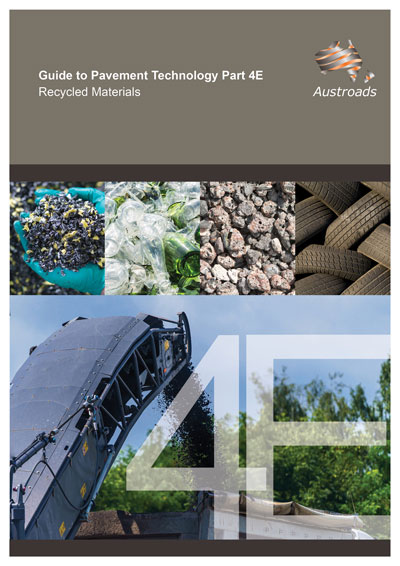Pavement

- Publication no: AGPT04E-22
- ISBN: 978-1-922700-47-6
- Published: 15 July 2022
- Edition: 2.0
- PDF (free) Download
Guide to Pavement Technology Part 4E: Recycled Materials presents the latest information about products manufactured from recycling various waste materials accepted through registered recycling and reprocessing facilities. This includes the specification, manufacture and application of products derived from the recovery of construction and demolition waste (C&D waste) from the building industry; reclaimed asphalt pavement (RAP) from pavement maintenance and rehabilitation activities; recycled rubber from end-of-life tyres (crumb rubber); industrial slag from manufacturing processes; fly ash from power generation; recycled plastics; and recycled glass.
Recycled materials are continually finding broader application within industry, and it is important that these materials are scrutinised prior to utilisation. An assessment tool has been developed to provide administrative agencies with a framework to rigorously scrutinise emerging materials for potential impacts to economic, environmental, societal and performance outcomes. This framework improves confidence in the uptake of recyclables through mitigation of risk and uncertainty to deliver higher quality assets.
Edition 2.0 is a major edition update with technical and structure amendments made to the entire Guide.
- Summary
- 1. Introduction
- 1.1 Scope
- 1.1.1 Insitu Recycling
- 1.2 Guide to Pavement Technology
- 1.3 Policy Environment
- 1.3.1 Changes to International Waste Policies
- 1.3.2 Domestic Changes in Waste and Recycling Legislation and Policy: Australia
- 1.3.3 Domestic Changes in Waste and Recycling Legislation and Policy: Aotearoa New Zealand
- 1.3.4 Responses in Transport and Infrastructure: Australia
- 1.3.5 Responses in Transport and Infrastructure: Aotearoa New Zealand
- 1.1 Scope
- 2. Aspects of Recycling
- 2.1 Circular Economy
- 2.2 Composition of Waste
- 2.3 Recycled Waste Volumes
- 2.4 Waste Hierarchy for Pavement Materials
- 2.5 Contaminants
- 3. Framework for Determining Recycled Materials Suitability
- 3.1 Framework Description
- 3.2 Initial Assessment Framework
- 3.3 Engineering Performance Framework
- 3.4 Environmental Performance Framework
- 3.5 Health & Safety Performance Framework
- 3.6 Project Performance Framework
- 4. Recycled Crushed Glass
- 4.1 General
- 4.2 Engineering Risk and Performance
- 4.3 Health, Safety and Environmental Risks
- 4.4 Economics
- 5. Recycled Plastic Waste
- 5.1 General
- 5.2 Engineering Risk and Performance
- 5.3 Health, Safety and Environmental Risks
- 5.4 Economics
- 6. Industrial Slag
- 6.1 General
- 6.2 Engineering Risk and Performance
- 6.3 Health, Safety and Environmental Risks
- 6.4 Economics
- 7. Recycled Tyres
- 7.1 General
- 7.2 Engineering Risk and Performance
- 7.3 Health, Safety and Environmental Risks
- 7.4 Economics
- 8. Reclaimed Asphalt Pavement
- 8.1 General
- 8.2 Engineering Risk and Performance
- 8.3 Health, Safety and Environmental Risks
- 8.4 Economics
- 9. Coal Combustion Products
- 9.1 General
- 9.2 Engineering Risk and Performance
- 9.3 Health, Safety and Environmental Risks
- 9.4 Economics
- 10. Recycled Crushed Concrete and Masonry
- 10.1 General
- 10.2 Engineering Risk and Performance
- 10.3 Health, Safety and Environmental Risks
- 10.4 Economics
- References
- Appendix A Protocol for assessing RM in asphalt mix and sprayed seal road surfacings
- A.1 Introduction
- A.2 Applications of RM in Asphalt and Sprayed Seals
- A.3 Established applications
- A.4 Assessment Criteria
- A.4.1 Benchmarking
- A.4.2 Consistency, Storage and Handling of RM
- A.4.3 Engineering Performance Assessment
- A.5 Environmental performance assessment
- A.6 Health and Safety Effects
- A.7 References
